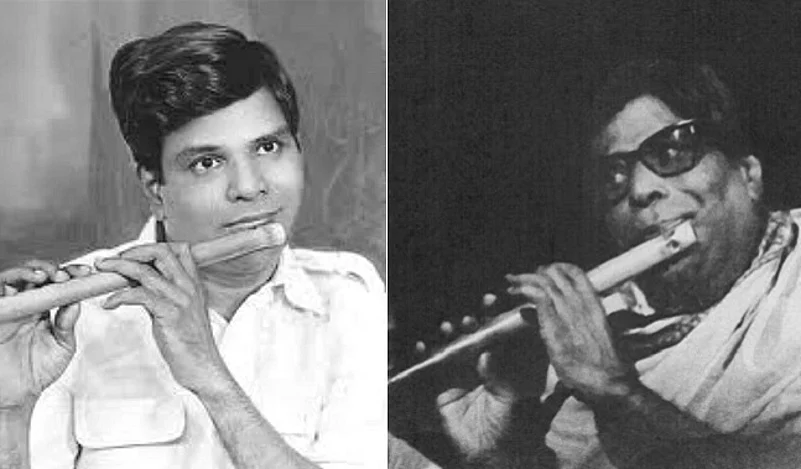No no no no, not at all that. In sudden desperation, T.R. Mahalingam shakes his right hand with a speed several times more than the eight-beat rhythmic cycle on which he is trying to improvise a solfa passage. His sudden deflection of body from left to right flummoxes not just the percussionist seated there; the whole concert stage gets filled with an air of puzzle that none succeeds to crack.
Flute Mali, as the celebrated classical musician is simply known, resumes his bid to advance further into the complicated labyrinth of notes he had himself chosen to explore. With his prime disciple N. Ramani, from behind displaying the aadi tala taps unwaveringly, things seem to be back on track—but that is again only for a brief while. Mali makes no effort to hide the apparent pitfall he has again fallen into, though he does seem to pass at least a part of the blame on to his accompanists on the stage.
Advertisement
The venue is Chennai, the citadel of Carnatic music. The year is 1985; in fact it’s the last night of it on December 31. The audience at the Krishna Gana Sabha is attentive—and that’s why there is consternation among the listeners when a genius no less than Mali appears struggling to proceed with a varied pattern of gaits (called nadai) that forms a rich feature during a detailed swaraprastaram in south Indian classical kacheri.
The Sankarabharanam-raga notes emerge out once more, this time the staccato is further prominent—and the flautist all of a sudden raises his hands up. That has possibly to do with unsatisfactory air circulation around: the absence of a ceiling fan? Or maybe his feeling that the resonance of the bamboo instrument is getting “stuck” somewhere up. Mali, in a dark- blue shirt, continues, and then does a repeat act—this time, he angles it even finer—to Ramani.
Advertisement
The pupil, typically, is cool. With a respectful smile, he continues to keep the time. In randu Kalai, which takes double the space or, effectively, a cycle of 16 beats. There is a third resumption, but this time Mali seems to have largely given up. In a matter of seconds, he pauses and places his head, slanting leftward to the support of his hand folded and the elbow digging into a pillow placed on his lap. One more salvage bid follows, but that is still shorter. A final attempt is longer, but from there on Mali winds up the exercise and gets back to the capping-up act of getting back to the lyrics of the popular composition.
Mali (1926-86), not to be misunderstood with the above one-off incident, is widely hailed as
the most revolutionary Carnatic flautist in its 20th century, arguable even of all time till date.
Studies say that the flute in the south Indian style was largely devoid of Carnatic-style oscillations (gamakas) till the entry of Mali at a very young age.
An apocryphal story has it that he, as a five-year- old boy, was seen playing “secretly” the ‘Viriboni’ varnam in weighty Bhairavi raga—in three speeds of the 18th-century composition bearing metric pieces known for their complexities.
A native of the temple town of Tiruvudaimarudur off the Cauvery-fed green belt of Thanjavur, he was only seven when he debuted (at the 1933 Thyagaraja festival in the Madras suburb of Mylapore). Soon he went on to gain complete mastery in his art that virtually defines new-age Carnatic flute-playing because quite a few subsequent exponents of the instrument are/were his disciples. In fact, Mali’s technique even led to a redesign of the Carnatic flute, whose reeds became thicker and the holes smaller.
Advertisement
As musicologist P. Sambamurthy (19-01- 73) notes, “It was the eighth and extra hole that helped provide Mali with the extraordinary control he has on the instrument.”
The artiste had always had his mood swings that led to a fascinating life profile that wasn’t all the same good news for Carnatic music. Incidents of his failing to show up at concerts became common about Mali, who began developing drinking problems as well. As the bohemian ways, coupled with ill-health, defined much of his prime (during which he was infrequent [from age 32 he went into a brief seclusion as well]), he equally presented several mind-blowing concerts. Then, a middle-aged Mali married an American student Ellen Chadwick in 1980 and migrated to her trans-Atlantic continent. There he stayed for five years before the flautist decided to return to his motherland, where his legion of admirers welcomed him with both hands.
Advertisement
So, it wasn’t much later after that Mali’s Krishna Gana Sabha concert happened. It did take off well what with the maestro essaying the lilting Anandabhairavi raga in a thoroughly refreshing way. O Jagadamba, the famed kriti of Syama Sastri (1762-1828) follows. With him on the concert stage are all eminent hands: Dwaram Mangathayaru on the violin, Mannargudi S. Easwaran on the mridangam, G. Harishankar on the ganjira and Pudukottai
Mahadevan on the morsing.
Once he ends up the botched-up effort on the Sankarabharanam swaraprastaram, Mali
begins to talk in diction that is unclear but a tone that sways towards apology. The front-row VIPs, including dancer-choreographer Sonal Mansingh, are in states ranging from pure stupor to resigned amusement. Mali regains wits and the concert is on—this time with a taniyavarthanam, where the mridangam, ganjira and morsing generate a rally of rhythmic rolls before eventually coalescing into a beautiful pattern.
Advertisement
Exactly five months after this concert (which was not his last, by the way), on May 31, 1986, Mali died. He suffered a brain haemorrhage in Bangalore and was half-a-year short of 60 when he breathed his last—only months after refusing to accept the Government of India’s coveted Padma Bhushan honour.




















